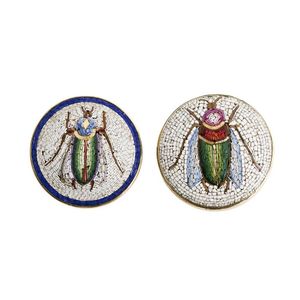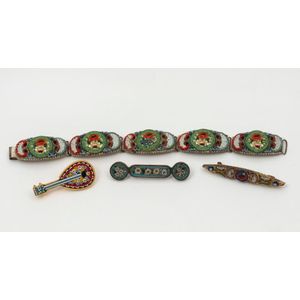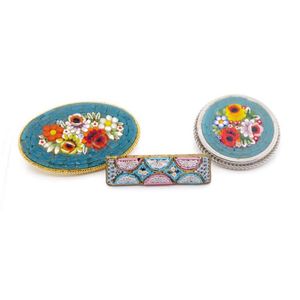
Grand Tour Micromosaic and Gold Beetle Shirt Studs, Rome 19th Century
Two similar Grand Tour Micromosaic and gold mounted beetle shirt studs, Rome, third quarter 19th century, each circular, set with a very fine micromosaic of Egyptian revival beetle motifs within a gold frame and post, the gold apparently unmarked but…

Vintage Micro Mosaic Brooch and Gold-Plated Enamel Locket Set
Two vintage items, comprising micro mosaic brooch and a gold plated and enamel locket.

Victorian Gold Micro Mosaic Brooch with Roman Forum Scene
Victorian Grand Tour C1870 gold micro mosaic brooch, finely worked mosaics with lapis lazuli base, ruins scene of the Roman forum in Rome on 15ct wire bead and rope frame 5.7 cm length (damged)

Victorian Grand Tour Micro Mosaic King Charles Spaniel Brooch
Original cased Victorian Grand Tour micro mosaic brooch, of a King Charles Cavalier spaniel set in onyx, 15ct gold frame, 5.5 cm length a/f

Victorian 9ct Gold Micro Mosaic Brooch with Bird and Butterfly
Victorian Grand Tour micro mosaic brooch, of rose stem with bird and butterfly in 9ct gold frame, 6.5 cm length a/f

Victorian 15ct Pietra Dura Mosaic Brooch with Floral Panel
Victorian 15ct frame pietra dura mosaic brooch oval panel of roses, forget me not's and lily of the valley flowers, 5 cm length

Micro Mosaic Dove Brooch with Missing Stones, 25mm Width
Antique micro mosaic dove brooch width 25 mm, missing some stones

1850 Micromosaic Brooch Featuring Roman Deity Flora in 18ct Gold
18ct gold Micromosaic brooch, circa 1850. The rectangular panel depicting the Roman deity flora, within an 18ct gold frame, length 50 mm, width 37 mm

Antique Italian Micro Mosaic Metal Bracelet, Length 21 cm
Large antique micro mosaic & metal bracelet marked Italy, length 21 cm, width 19.5 mm

Micro Mosaic Roman Drop Earrings in 9ct Yellow Gold
Micro mosaic & yellow gold drop earrings unmarked. Showing the ruins of the Colosseum, and the Romanum forum. Appprox size 24 x 18 mm, minor chips wear. Total weight 14 grams, tests as 9ct

Micro Mosaic Gold Plated Jewelry Set with 5cm Brooch
Micro mosaic and gold plated bracelet, earrings, necklace and brooch set, the brooch 5 cm wide

Antique micro mosaic cross with mother of pearl and rose gold
Antique micro mosaic, mother of pearl & rose gold cross size 42 mm x 25 mm repaired

Victorian Florentine Mosaic Lily Flower Bud Oval Brooch 46mm
Victorian Florentine mosaic brooch, unframed oval panel of lily flower and bud 46 mm length

Victorian Gold Pietra Dura Florentine Mosaic Brooch and Earrings
Victorian Grand Tour C1870 gold pietra dura Florentine mosaic brooch and earrings, oval white rose pattern on finely wire worked frame with matching earrings, one with extra hanger, 45 mm brooch length (not including suspender)

Victorian Micro Mosaic Scarab Beetle Brooch in 14ct Yellow Gold
Victorian micro mosaic set yellow gold brooch showing a scarab beetle. Unmarked, stone size 16 mm, item weight 9.65 grams, tests as 14ct

Jet and Micro Mosaic Brooch in Bone Setting, Cracked
Jet and micro mosaic brooch in a applied likely bone setting. Approx width 44 mm, crack to bone

19th Century Micro Mosaic and Gold Fleur-de-Lis Brooch
A fine quality 19th century 15ct gold and micro mosaic brooch, the fine micro mosaic oval panel in a still life design set to an oval mother-of-pearl panel within a gold frame with repeating fleur-de-lis type embossed motif, length 5 cm.

Vintage Micro Mosaic Bracelet and Three Gilt Brooches Set
Micro mosaic vintage bracelet and three brooches, all set in gilt metal, 20th century, (4 items), the bracelet 19 cm long

Dove Micro Mosaic Pendant Brooch: Antique Silver Gilt
Antique micro mosaic & silver gilt pendant brooch. Showing a dove approx size 47 x 47 mm

18ct Gold Micromosaic Bracelet with Archeological Scenes Panels
W. M Hawkes & Son, 18ct gold micromosaic bracelet; comprising five oval onyx and micromosaic panels depicting archeological scenes, each within a cannetille gold surround, completed by a bolt ring clasp, unsigned, length approximately 210 mm.; accompanied…

Gold Micro Mosaic Swan Brooch with Locket Compartment
A 19th century 9ct gold micro mosaic brooch, fine inlaid brooch featuring a swan or duck, with surrounding bead detail and locket compartment to rear, metal pin, size 29.4 x 23.8 mm, wt. 10.8g.

Antique Micro Mosaic Brooch of Roman Forum
An antique gold cased micro mosaic brooch, finely inlaid scene of a Roman Forum, size 58 x 48 mm.

Bird & Flower Micro Mosaic Earrings & Brooch Set
Antique micro mosaic earrings and brooch suite, all featuring birds and flowers on black ground, disc earrings (abraded) to gold plated fames and later 9ct gold shepherds hook fittings, size 40 x 25 mm, and rectangular plaque brooch (some chips and…

19th Century Micro Mosaic Floral Brooch in Gold Mount
An antique micro mosaic floral brooch in yellow gold mount, 19th century, 5 cm wide

Italian Micro Mosaic Bee Stick Pin, 18ct Gold
19th century Italian gold micro mosaic stick pin, tested 18ct gold, hallmarked to side of pin with crossed keys of St Peter's Rome, with micro mosaic depiction of a bee (possibly relating to the crest of the aristocratic Barberini family of Rome), set…

Micro Mosaic Heart Brooch - Early 20th Century
Early 20th century. Micro mosaic heart form brooch, size 26 x 24 mm

Italian Micro Mosaic Brooch - Antique
Antique micro mosaic brooch marked made in Italy, size 47 x 30 mm

Colorful Beetle Micromosaic Pendant
Micromosaic pendant, depicting a brightly coloured beetle set in a shield shaped pendant, with hinged glazed panel verso, measuring 4.2 x 2.1 cm.

Micro Mosaic Bracelet, 20 cm Length
Early 20th century micro mosaic bracelet width 11 mm, length 20 cm

Victorian Micro Mosaic Brooch of St. Peter's Basilica
A Victorian 9ct rose gold micro mosaic brooch, St Peter's Basilica, Wt 10.3 grams

Italian Micro Mosaic Brooches, Early 20th Century
Three micro mosaic brooches two marked Italy. The early 20th C piece has a kink to the border

Vintage Brooch Lot: Micro Mosaic, Deco Silver & Sterling
Three vintage brooches approx includes, micro mosaic piece marked Made in Italy, A Deco period floral basket silver and marcasite brooch marked 935, and another marked sterling silver

Micro Mosaic Brooch Trio: Early 20th & Mid Century Pieces
Three micro mosaic brooches includes a early 20th century. Piece and two mid century pieces

1930s Italian Micro Mosaic Brooch Collection
Three antique Italian micro mosaic brooches, circa 1930's.

Opal Butterfly Brooch in 9ct Gold
Opal mosaic brooch, 9ct yellow gold designed in the form of a butterfly, set with Lightning Ridge opal, with two solid white opals to the body, total weight 9 grams

Victorian Swans Micro Mosaic Earrings
Victorian micro mosaic drop earrings, c. 1890s, gold and base metal, depicting swans, fitted with hinged wire fittings

Grand Tour Micro-Mosaic Brooch with Roman Ruins
Victorian 18ct frame Grand Tour mosaic brooch oval micro-mosaic panel of Roman ruins (faults)

Gold Micromosaic Love Brooch with Doves and Flowers
A late 19th century gold Micromosaic love brooch, featuring doves with flowering branches on blue ground to bead and wirework centre detail and frame surround in bloomed 18ct gold, size 58 x 21 mm, wt. 9.08g.

9ct Rose Gold Micro Mosaic Onyx Brooch, Antique
Antique micro mosaic set 9ct rose gold brooch marked 9ct, onyx size 20 x 16 mm, item weight 5.6 grams

Micro Mosaic 9ct Gold Brooch - Antique
Antique micro mosaic and 9ct yellow gold brooch marked 9ct, size 26 x 21 mm

Italian Micro Mosaic Brooch, Mid-Century, 35mm Length
Mid century micro mosaic brooch rubbed Italy marks. length 35 mm

Unmarked Early 20th Century Micro-Mosaic Brooch - 28mm
Early 20th century micro-mosaic brooch unmarked. size 28 mm

Grand Tour Malachite Pendants with Micro Mosaic Work
Pair of 19th century Grand Tour pendants, of teardrop form in 18ct yellow gold and malachite, featuring intricate micro mosaic work depicting Roman ruins, one a/f (past repair), pendant height 4.5 cm (2)

Micro Mosaic Roman Ruins Pendant in 18ct Gold
19th century Grand Tour micro mosaic pendant, of teardrop form in 18ct yellow gold and malachite, with oval shaped micro mosaic depicting Roman ruins, pendant height 4.4 cm

Grand Tour Micro Mosaic Pendant of Pantheon in Rome
19th century Grand Tour micro mosaic pendant, of oval form in a 9ct marked gold mount, depicting the Pantheon, Rome in micromosaic against lapis stone, a/f with chip bottom left, pendant height 4 x width 3.3 cm

Antique Micro-Mosaic Earrings in Yellow Gold
A pair of antique yellow gold and micro-mosaic earrings, 19th century, 1.8 cm high

Micro Mosaic Brooch - 19th Century Yellow Gold
19th century micro mosaic and yellow gold brooch unmarked, brooch size 54 x 45 mm, weight 25 grams, light wear to edges

Archeological-Revival Micromosaic Gold Pendant Necklace
An archeological-revival gold and micromosaic pendant necklace circa 1870, the circular pendant centrally-set with a fine polychrome micromosaic depicting a scarab within an engraved acanthus leaf surround, further framed by gold wirework and granulation,…

Assorted Micromosaic Jewelry: Bracelet and Heart Brooches Set
Four pieces of micromosaic jewellery includes: early 20th century bracelet and three mid century heart brooches, bracelet length 20 cm

19th Century Italian Micro Mosaic Plaque and Brooch
An Italian micro mosaic plaque and brooch, 19th century, the plaque of oval form, featuring a floral decoration to centre on a black ground, the silk backing verso reading C. Roccheggiani/ Roma. (repaired), the brooch comprising three small oval plaques,…

Victorian Micro Mosaic and Gold Stick Pin
Victorian micro mosaic and yellow gold stick pin. Approx mosaic size 9 mm, total weight 3.6 grams, tests as 18ct. Provenance: The Logan estate.

Etruscan-style Micro Mosaic Brooches, Set of Two
Two micro mosaic brooches includes a good antique piece with Etruscan style borders as well as a oval piece. Size 22 mm square, 25 x 35 mm

Micro Mosaic St. Peter's Square Brooch
Micro mosaic brooch, featuring a detailed scene of St Peter's square, Rome, inlayed into an onyx plaque with sterling silver frame and brooch fitting, stamped 'Stg.Silver', 44 grams

Italian Cameo and Mosaic Brooches Set
Vintage Italian cameo and mosaic brooches, 2 oval carved cameo shell portraits set in 800 silver frames with brooch and pendant fittings, one with marcasite's, sizes 39 x 30 & 32 x 25 mm, and 4 micro mosaic brass brooches including 2 disc with flowers and…

Micro Mosaic Gold Pendant with Photo Locket
A 19th century gold and micro mosaic pendant/photo locket, the front decorated with a micro mosaic floral design, the back with glass for photo. (testing as 22ct).

Italian Micro Mosaic Brooch, Early 20th Century
Early 20th century micro mosaic brooch marked made Italy. Approx width 24.5 mm

Grand Tour Micro-Mosaic Brooch of St. Peter's Square
A 19th century Grand Tour gold mounted micro-mosaic brooch, the finely laid miniature tesserae showing a scene of St. Peter's square, the Vatican, Rome, within a sunstone oval and gold mount, clip, safety chain and loop to the reverse, 4 cm high, 5 cm…

Micro-Mosaic Courtyard Brooch
A 19th century micro-mosaic and rolled gold brooch, the elaborate courtyard scene with central obelisk. Width 3.5 cm.

Micro-Mosaic Rose Gold Pendant with Elaborate Entrance Design
A late 19th century European micro-mosaic and 9ct. rose gold pendant, the oval panel with elaborate wall entrance, the plain frame with some old repair, pendant mount. Width 4.2 cm.

Italian Micro Mosaic Brooch and Pendant Set
Two micro mosaic items, a brooch and a pendant, made in Italy.

Micro Mosaic Crescent Moon Brooch
Antique micro mosaic brooch of an upward crescent moon design, width 27 mm

Assorted Collection of Dress Studs and Buttons
A collection of dress studs and buttons, including a boxed suite of micro mosaic cuff-links and buttons showing Roman scenes, a suite of pietra dura buttons in fitted box, and a suite of gold and amethyst buttons in fitted box

Micro Mosaic Vatican Watch Key, 1800
A rare early 19th century watch key, set with two oval micro mosaic panels depicting views of Vatican city. Circa 1800.

Italian Micro Mosaic Brooch with St. Peter's Basilica
An antique Italian micro mosaic brooch, featuring St Peters Basilica within an onyx surround set in white metal, size 38 x 30 mm, minor damage.

Victorian 18ct Filigree Urn Locket with Micro Mosaic Top
Original boxed fine Victorian 18ct locket/pendant in the shape of an urn with quality detailed filigree decoration to front and back micro mosaic to top and opens up to an oval locket inside, 7 cm high, 2.5 cm wide,n

Beetle Micro Mosaic Brooch in 15ct Gold
A micro mosaic brooch, the finely detailed mosaic plaque depicting a beetle, centred within a decorative bar with scrolled and applied gold decoration, in 15ct gold.

Spaniel Micro Mosaic Brooch in 15ct Gold
A gold micro mosaic brooch, the finely detailed mosaic depicting a spaniel, within a blue border and engraved surround, in 15ct gold.

Micro Mosaic Flower Brooch with Silver Gilt, 25mm Width
Antique micro mosaic flower brooch set in silver gilt. Approx size 25 mm width, showing some loss

Micromosaic Demi-Parure with Peasant Vignettes, 19th Century
A gold mounted micromosaic demi-parure, mid 19th century, comprising: a necklace designed as a graduated line of 26 micromosaic vignettes alternatively depicting peasants in regional costumes between foliate sprays, applied on opaque green glass within a…

Victorian 14ct Gold Dove Mourning Locket
Victorian micro mosaic mourning locket depicting a dove. Approx locket size ex bail 20 mm x 25 mm, Tests as 14ct gold in parts, total weight 8.4 grams

Colorful Micro Mosaic Lady's Bracelet
Lady's micro mosaic bracelet, in the form of alternating circular panels, in tones of red, blue and white

Italian Micro Mosaic Flower Brooch
Italian silver and micro mosaic brooch, of oval form, decorated with flowers, in tones of red, white, yellow and green, with beaded surround, length 5 cm

9ct Gold Micro Mosaic Brooch with Onyx Backing
1 x micro mosaic brooch 1 x 9ct yellow gold Carris Brothers WA micro mosaic brooch with onyx backing.

Micro Mosaic and Marcasite Brooches
A good Antique micro mosaic brooch polychrome floral patterns set in a brass setting. As well as sterling silver marcasite ribbon brooch.

Georgian Gold Memento Mori Micro Mosaic Ring
Georgian micro mosaic ring with Momento Mori (mourning) in 24ct gold depicting a classic tomb surmounting raised gold frame

Antique Micro-Mosaic Gold Brooch with Locket Back
Antique boxed gold and micro-mosaic brooch, in 14ct gold (unmarked but tested) with floral mosaic and floral surround and an open locket back, total weight 24.95 grams, 5.5 by 4.5 cm

Georgian Gold Micro-Mosaic Clasp with Traditional Dancers, 1826
A Georgian micro-mosaic clasp, the oval clasp depicting two figures dancing in traditional costume. yellow gold. Weight 10.9 grams. Length 29 mm. Inscription to reverse '3rd Oct, 1826'

Italian Micro-Mosaic Brooch with Complete Stone Set
Vintage large Italian micro-mosaic brooch, all stones present

9ct Gold Micro-Mosaic Locket with Back Opening
Antique 9ct gold micro-mosaic locket, opening at the back. Total weight 5.6gms

Antique 9ct Gold Micro-Mosaic Locket
Antique 9ct gold micro-mosaic locket, opening at the back. Total weight 5.6gms

Silver Scarab Micro-Mosaic Brooch
A micro-mosaic brooch, the central scarab on a tapering bar brooch. Silver gilt. Boxed.

Italian Micro-Mosaic & Onyx Brooch
Antique Italian micro-mosaic and onyx brooch, size: approx 4.5 by 3.5 cm

Victorian Micro-Mosaic Grape Earrings
A pair of Victorian micro-mosaic earrings, the oval mosaic panel set in gold openwork frames with applied grape and leaf motif. yellow gold. Weight 15.87 grams. Length 35 mm. Hook attachments

9ct Micro-Mosaic Lion Brooch with Goldstone
Vintage 9ct brooch with micro-mosaic lion, in centre and goldstone (tested as 9ct but unmarked), weight: approx 8.7 grams

Etruscan Revival Micro-Mosaic Bee Brooch
A 19th century Etruscan Revival micro-mosaic bead brooch, 18ct. (tested) gilded gold, circular shape, the domed front set with a bee in polychrome micro-mosaics framed by an arcade border. Diameter 2.5 cm











 Loading more...
Loading more...